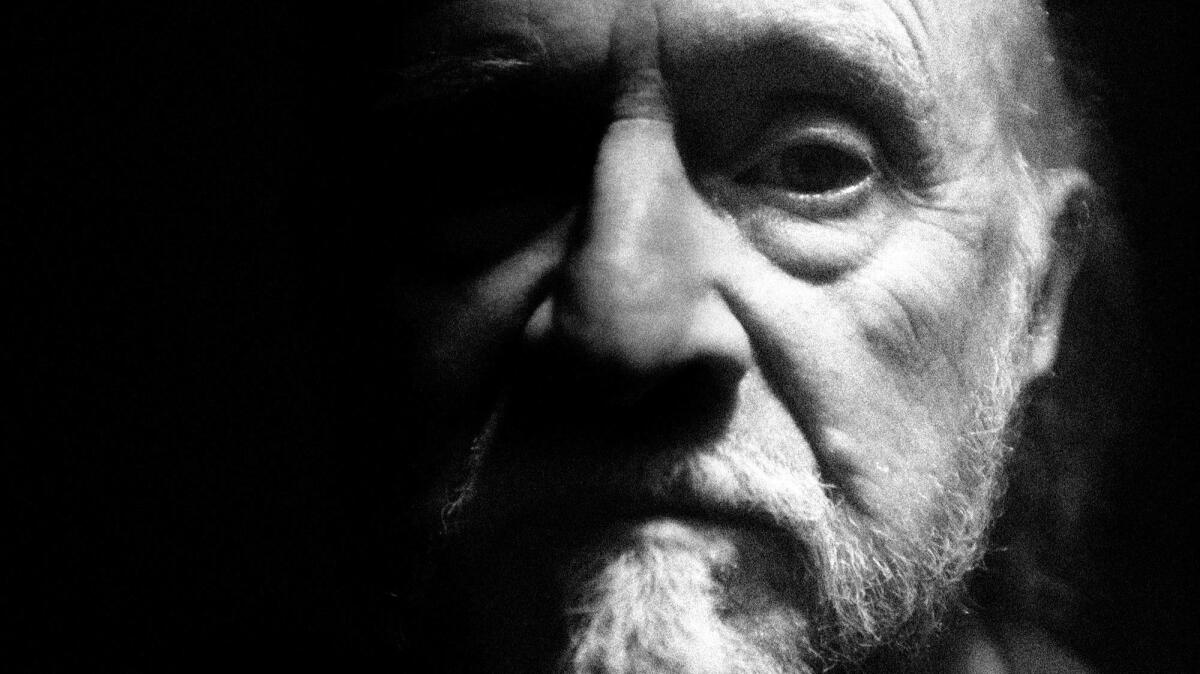The scary delights of Richard Matheson

- Share via
Going as far back as the ’60s, many of my most indelible schoolyard memories concern the breathless, morning-after enthusiasms my friends and I exchanged over “Twilight Zone” episodes, such as “Death Ship,” “Third From the Sun” or “Nightmare at 20,000 Feet” (“and when they landed the plane, and they’re draggin’ this guy off to the booby hatch, it turns out that the wing of the plane really was torn to bits, and everybody was almost killed”). In those fading screen-lit stories that we tried to keep alive the next morning among the rusty swings and slides, we had discovered how inventive and surprising the world could be. It made us want to purvey those distinctly narrative pleasures we had received to each other. It made us want to be writers.
The best of these episodes were almost always written by, or adapted from stories by, Richard Matheson. As Victor LaValle notes in his introduction to this welcome, Halloween-timed retrospective collection from Penguin Classics, many of us loved Matheson’s fiction long before we ever read him or knew his name. Often, our first exposures were either through “Twilight Zone” teleplays or various big-screen adaptations (usually scripted by Matheson himself) such as “The Incredible Shrinking Man” (1957) and “The Legend of Hell House” (1973), and the made-for-TV movies “Duel” (1971) and “The Night Stalker” (1972).
Almost every memory I have of being both frightened and absorbed by a modern story relates back to Matheson. Even the worst film interpretations of his work managed to reproduce some spark of the original genius. Fifty years later, I still recall watching the first film adaptation of Matheson’s revisionist vampire classic “I Am Legend” on the late-night movie. It was the now disregarded, cheapo Italian film “The Last Man on Earth” (1964), and despite its clumsy sets, pancake cosmetics and creaky, sun-stained camera work, it lingers more vividly in my mind than the later, gussied-up, high-tech studio versions starring Charlton Heston (“The Omega Man,” 1971) and Will Smith (2007’s “I Am Legend”). This is probably because Matheson’s stories never shock viewers with gruesome effects or CGI wondrousness; instead, they worry them at the human level. And they never let a reader go until they’re finished.
It’s possibly one of the reasons Matheson never became as well-known as he should have been: When he finished with a story, there was nothing left over to spin into endless sequels or anthologies (no “I Am Legend: Miami Shakedown”). Nobody burned a plot idea down to ash like Matheson.
And while he had the gift of writing stories filled with those tight little through-lines that movie people love, his fiction was pre-eminently literary. He always knew where to start a story on the page; and he never padded it with needless plot digressions, flashbacks and repeat-as-needed atrocities. If Matheson had written “The Stand,” it would be 12 pages long. It would be scary. And when it was over, it wouldn’t need another word. Except maybe this one: “Ahh.”
Even mediocre film versions of Matheson are more absorbing than they might first appear. And even his oldest, most dog-eared stories are still being recycled as big-budget Hollywood movies 50 or 60 years after they were first composed. Take, for example, Hugh Jackman’s “Real Steel” (the 2011 film based on Matheson’s 1956 story “Steel”). Or the potentially maudlin Robin Williams journey through the afterlife, “What Dreams May Come” (1998), in which Matheson does for heaven what he did for the vampire — makes it plausible. Those movies may look awful when you first flick onto them via our crap-glutted televisions — but just start watching one of them, and I dare you — try to stop.
There was nothing left over to spin into endless sequels or anthologies.... Nobody burned a plot idea down to ash like Matheson.
In Matheson’s hands, even a gimmicky genre idea such as “The Shrinking Man” (1956) will keep readers up at night. In that fairly obvious science-fiction set-up (atomic-era guy suffers endless miniaturization after being exposed to a nuclear test), there’s one extra twist that comes along to make it snap: It’s not simply that he’s getting smaller, but that as he gets smaller, he grows more arrogant and angry. Eventually, after descending to the microscopic level in his spider-ridden basement, he marches triumphantly into the garden, ready to face anything. Only Matheson could make you believe in these preposterous-seeming stories. And leave you wanting more.
Matheson never did the same thing twice; and like the great Cornell Woolrich (the writer he most resembles), he always sets the fictional clock ticking on the first page. Stylistically, he adapted his prose to his characters with all the joie de vivre of a Faulkner. Take, for example, this opening passage from his first published story, “Born of Man and Woman” (1950), written when he was 22:
This day when it had light mother called me retch. You retch she said. I saw in her eyes the anger. I wonder what it is a retch.
Like many Matheson characters, this grotesque, unlovable and increasingly distraught narrator has been hidden away in the basement of an otherwise normal suburban family ever since his unfortunate “birth.” But that doesn’t mean he’ll stay there. Four pages of fiction you won’t forget.
Matheson’s characters often come up hard against the dullest, hottest, least extraordinary landscapes of American life: desert-locked coffee shops and diners, muzak-thrumming shopping malls and post-World War III punk rock bars. But however mundane and familiar those landscapes might first appear, they quickly take turns into darker territories: In “Dying Room Only,” a couple stop in a creepily male-dominated off-road diner, where the husband goes into the bathroom and never comes out; in “Prey,” a young woman fights a lonely battle against a knife-wielding devil doll, then just as she achieves an edgy standoff, considers inviting her overbearing, boyfriend-devouring mother over for a drink.
Matheson even refuses to leave Christmas alone with his tale of holiday wishes coming true (and not) in “A Visit to Santa Claus.” After all, what better time to ring out the old wife and ring in the new one? Fa la la.
But it’s not Christmas yet, and since it’s only just about Halloween, this is really the time to sing songs for Matheson. As Rod Serling might say: Taken as Exhibit A. What appears to be on the surface a book of nicely printed stories. Well-designed. Reputable publisher. There’s even a cute little penguin on the cover. Go on. Let it into your house. Leave it on the coffee table while you go upstairs, undress and fix yourself a drink. It’s time to relax in a region beyond space and time. In a region where, when you aren’t looking, the cute little penguins bite.
Bradfield is a novelist and critic. His most recent book is the novel “Dazzle Resplendent: Adventures of a Misanthropic Dog.”
“The Best of Richard Matheson”
Richard Matheson, introduction by Victor LaValle
Penguin Classics: 432 pp., $17 paper
More to Read
Sign up for our Book Club newsletter
Get the latest news, events and more from the Los Angeles Times Book Club, and help us get L.A. reading and talking.
You may occasionally receive promotional content from the Los Angeles Times.









